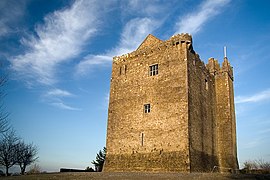
Back Brehon Laws German Leyes Brehon Spanish Brehon legeak Basque Lois des brehons French An Féineachas Irish Древнеирландское право Russian Brehonernas lag Swedish Середньовічне ірландське право Ukrainian
This article possibly contains original research. (November 2019) |

Early Irish law,[1] also called Brehon law (from the old Irish word breithim meaning judge[2]), comprised the statutes which governed everyday life in Early Medieval Ireland. They were partially eclipsed by the Norman invasion of 1169, but underwent a resurgence from the 13th until the 17th century, over the majority of the island, and survived into Early Modern Ireland in parallel with English law.[3][page needed] Early Irish law was often mixed with Christian influence and juristic innovation. These secular laws existed in parallel, and occasionally in conflict, with canon law throughout the early Christian period.
The laws were a civil rather than a criminal code, concerned with the payment of compensation for harm done and the regulation of property, inheritance and contracts; the concept of state-administered punishment for crime was foreign to Ireland's early jurists. They show Ireland in the early medieval period to have been a hierarchical society, taking great care to define social status, and the rights and duties that went with it, according to property, and the relationships between lords and their clients and serfs.
The secular legal texts of Ireland were edited by D. A. Binchy in his six-volume Corpus Iuris Hibernici. The oldest surviving law tracts were first written down in the seventh century and compiled in the eighth century.[4]
- ^ Historically referred to as Féineachas (English: Freeman-ism) or Dlí na Féine (English: Law of Freemen).
- ^ Ireland (1879). Ancient Laws of Ireland: Din tectugad and Certain Other Selected Brehon Law Tracts. H.M. Stationery Office.
- ^ Lyall 2000.
- ^ Ó Cróinín, Dáibhí (2013). Early Medieval Ireland, 400–1200.
© MMXXIII Rich X Search. We shall prevail. All rights reserved. Rich X Search